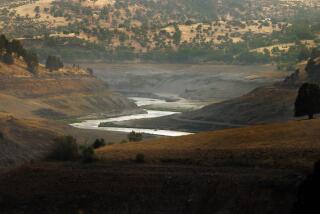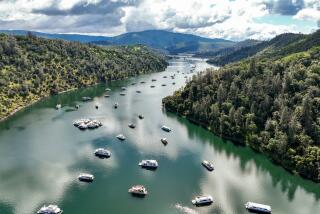Op-Ed: Dams are like loaded weapons. Oroville could be the first disaster of many to come
- Share via
What is most surprising about the near-collapse of a spillway at Oroville Dam is that events like that have not happened more often.
Located 75 miles north of Sacramento, Oroville is the nation’s tallest dam and holds back the state’s second-largest reservoir. Both its main spillway and an auxiliary one have experienced major erosion because of massive emergency releases of reservoir water during this winter’s heavy storms. On Sunday, engineers worried that the top 20 or 30 feet of the emergency spillway could give way, causing devastating flooding on the Feather River. State officials ordered the evacuation of nearly 200,000 people living downstream from the dam.
This drama and danger could have been averted. Three environmental groups — Friends of the River, the Sierra Club and the South Yuba Citizens League — anticipated precisely the crisis that has unfolded this week. In response to the dam’s relicensing application in 2005, they filed a motion with federal officials to require that the earthen hillside that comprises the auxiliary spillway be covered with concrete to prevent erosion.
But according to the San Jose Mercury News, federal officials dismissed the request on the grounds that even if the emergency spillway suffered “significant damage,” it would not threaten control of reservoir water or endanger the dam itself. Instead, the officials sided with the California Department of Water Resources and the state water districts that probably would have had to pay for the new construction.
In general, Southern California water users not only consume Northern California water but significantly underpay for it.
Ron Stork, policy director of Friends of the River, said state water officials told him privately at the time that the Metropolitan Water District of Southern California and other water contractors that buy Oroville’s water did not want to pay the additional costs. “I felt a little disrespected and damn disappointed that they didn’t listen to me, particularly in the last week,” Stork told me Monday.
Metropolitan general manager Jeffrey Kightlinger, in the Los Angeles Times, claimed his agency “did not say it was a cost issue.” The water district deferred to state and federal officials, he said, who determined the emergency spillway met guidelines that “talk about how you don’t put a lot of funding and concrete, etc. into emergency spillways because presumably they will rarely if ever be used.”
The south-versus-north dynamic is an old one in the state’s water politics. In general, Southern California water users not only consume Northern California water but significantly underpay for it. Now, the people who live downstream from the Oroville Dam, who must continue to be prepared for evacuations “at a moment’s notice,” are paying dearly for what should have been covered by Southern California rate-payers a decade ago. On top of this, even if the dam’s spillways suffer no further damage, the cost of repairing the spillways will no doubt far exceed the expense of the preventive measure proposed in 2005.
Even more disturbing, Oroville is far from unique among the nation’s nearly 100,000 dams in needing repair. Dams usually require significant maintenance between their 25th and 50th birthdays, and virtually all U.S. dams are at least 40 years old; some were built more than a century ago. (Oroville will be 50 years old next year.)
Yet few dams are getting the repairs they need. The last time the American Society of Civil Engineers issued its Infrastructure Report Card was in 2013, when it gave U.S. dams a “D” grade and reported that more than 4,000 are deficient. The group will publish a new report card next month; while its contents haven’t been released, a spokesperson told me the conclusions of the 2013 report card are “still fairly accurate.” A 2016 survey by the Association of State Dam Safety Officials estimated the cost of repairing deficient dams that currently place downstream residents at risk at $22.91 billion. Carrying out that task would take many decades.
Rather than fund that work, politicians prefer to be seen cutting ribbons while standing in front of new dams. Even now, California officials are considering construction of more dams while much of the existing stock needs repair. From time to time, legislation is introduced in Congress to begin dam repair, but it inevitably dies.
President Trump has spoken of launching a massive plan to revitalize American infrastructure, but he has not issued a detailed proposal, and in any case, he seems to favor financing new construction with public-private partnerships that would work for, say, toll roads, but not dams.
Without a major repair program, the passage of time will further compromise dam safety. As the human population grows, more people are living downstream from vulnerable dams, usually without any idea of the risk they are taking. Climate change is intensifying that risk by inducing intense precipitation events and runoff that dams were not designed to handle. Indeed, climate change probably caused or at least deepened the five-year drought that preceded this winter’s heavy rain in Northern California. The drought almost certainly lowered the capacity of soil in the Oroville watershed to absorb water and increased storm runoff into the reservoir.
In 2005, I wrote that large dams “are loaded weapons aimed down rivers, pointed at ourselves; they’re proof of the gambling nature of the societies that build them.” A decade later, we have taken no significant steps toward disarming dams. Instead, our gamble has intensified.
Jacques Leslie is a contributing writer to Opinion and the author of “Deep Water: The Epic Struggle Over Dams, Displaced People, and the Environment.”
Follow the Opinion section on Twitter @latimesopinionand Facebook
UPDATES:
10:15 a.m.: This op ed was updated to reflect new information.
More to Read
A cure for the common opinion
Get thought-provoking perspectives with our weekly newsletter.
You may occasionally receive promotional content from the Los Angeles Times.










